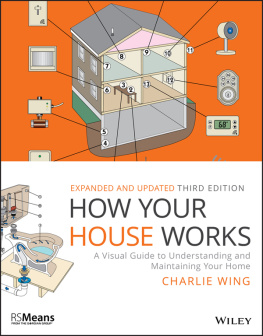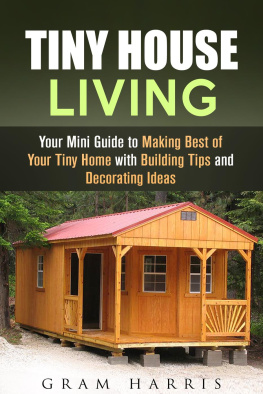
Table of Contents
Guide
Pages
THE TINY HOUSE HANDBOOK
Charlie Wing

For the next generation...
in hopes they restore
us to sanity
This book is printed on acid-free paper.
Copyright 2021 by Charlie Wing. All rights reserved
Published by John Wiley & Sons, Inc., Hoboken, New Jersey
Published simultaneously in Canada
No part of this publication may be reproduced, stored in a retrieval system, or transmitted in any form or by any means, electronic, mechanical, photocopying, recording, scanning, or otherwise, except as permitted under Section 107 or 108 of the 1976 United States Copyright Act, without either the prior written permission of the Publisher, or authorization through payment of the appropriate per-copy fee to the Copyright Clearance Center, 222 Rosewood Drive, Danvers, MA 01923, (978) 750-8400, fax (978) 646-8600, or on the web at www.copyright.com . Requests to the Publisher for permission should be addressed to the Permissions Department, John Wiley & Sons, Inc., 111 River Street, Hoboken, NJ 07030, (201) 748-6011, fax (201) 748-6008, or online at www.wiley.com/go/permissions .
Limit of Liability/Disclaimer of Warranty: While the publisher and the author have used their best efforts in preparing this book, they make no representations or warranties with respect to the accuracy or completeness of the contents of this book and specifically disclaim any implied warranties of merchantability or fitness for a particular purpose. No warranty may be created or extended by sales representatives or written sales materials. The advice and strategies contained herein may not be suitable for your situation. You should consult with a professional where appropriate. Neither the publisher nor the author shall be liable for any loss of profit or any other commercial damages, including but not limited to special, incidental, consequential, or other damages.
For general information about our other products and services, please contact our Customer Care Department within the United States at (800) 762-2974, outside the United States at (317) 5723993 or fax (317) 572-4002.
Wiley publishes in a variety of print and electronic formats and by print-on-demand. Some material included with standard print versions of this book may not be included in e-books or in print-on-demand. If this book refers to media such as a CD or DVD that is not included in the version you purchased, you may download this material at http://booksupport.wiley.com . For more information about Wiley products, visit www.wiley.com .
Library of Congress Cataloging-in-Publication Data:
Names: Wing, Charles, 1939- author.
Title: The tiny house handbook / Charlie Wing.
Description: Hoboken, NJ: Wiley, [2020] | Includes index.
Identifiers: LCCN 2020031687 (print) | LCCN 2020031688 (ebook) | ISBN 9781119581871 (paperback) | ISBN 9781119581895 (adobe pdf) | ISBN 9781119581864 (epub)
Subjects: LCSH: Small housesDesign and constructionHandbooks, manuals, etc. | House constructionHandbooks, manuals, etc. | House constructionPictorial works.
Classification: LCC NA7533 .W56 2020 (print) | LCC NA7533 (ebook) | DDC 728/.37dc23
LC record available at https://lccn.loc.gov/2020031687
LC ebook record available at https://lccn.loc.gov/2020031688
Cover Design: Wiley
Cover Illustrations: Courtesy of Charlie Wing
INTRODUCTION
The idea of living in a tiny house is not new. Outside of the developed world, most of the worlds people live in shelters no larger than those now defined in the US as tiny (less than 400 square feet). We have all read of and seen photographs of the Eskimo igloo, Native American teepee, Bedouin Arab tent, Gypsy vardo, Mongolian yurt, and Aboriginal dome. These are not temporary shelters, nor are they what Americans call starter homes. Rather, they are, and have been for millennia, the standard homes for their cultures.
For reasons this book does not address, the average new home in the US has grown to 2,400 square feet of living space, four bedrooms, three bathrooms, and a two-car garage. While many, and probably most, Americans aspire to ownership of these McMansions, an increasing number are questioning, What if a person gets everything and its not enough?
The tiny house movement is not just about tiny houses. Its about lifestyle; its about less is more; its about a smaller footprint but a larger life.
There are already many books on the tiny house philosophy and lifestyle.
Next page















